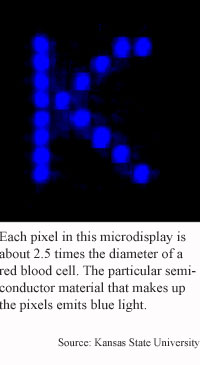
Chip promises brighter wearable displays
By Eric Smalley, Technology Research NewsTiny computer displays that can be mounted on eyeglasses and visors would be brighter, faster and sturdier if they could be made out of semiconductor chips rather than the liquid crystal and organic materials currently used.
It's hard to coax light out of silicon, however, and the semiconductor has to produce the right kind of light. Some common semiconductors like gallium arsenide emit red light, which limits their usefulness. The impetus to find an appropriate semiconductor has also been limited because liquid crystal displays and light-emitting diodes are generally cheaper than semiconductors.
Researchers at Kansas State University have come up with a viable semiconductor alternative by making tiny light-emitting diodes (LEDs) out of the semiconductor III-nitride. The researchers used them to fashion a prototype microdisplay that is brighter and has a wider viewing angle than microdisplays based on today's technology.
Semiconductor-based microdisplays are also inherently more shock-resistant and can operate in a wider temperature range than liquid crystal and organic LED microdisplays, making them more appropriate for the military, industrial and emergency services applications the displays are largely intended for.
The key to making full-color semiconductor displays is that III-nitride emits blue light, said Jingyu Lin, an associate professor of physics at Kansas State University. Because blue light is at the high end of the visible light spectrum it can be converted to lower frequencies.
"We can downconvert some of the pixels for example to red, some of them to green, so we can actually get full color from our semiconductor," said Lin.
The prototype display is an array of 100 pixels that are each 12 microns in diameter. The display measures half a millimeter by half a millimeter. A practical microdisplay would probably need an array of 600 by 500 pixels and would likely measure about an inch by an inch, said Lin.
The device works much faster than either liquid crystal displays or organic LEDs, said Lin. While liquid crystal displays can be turned on and off on the order of milliseconds and organic LEDs in microseconds, "semiconductor is intrinsically below the nanosecond scale," she said.
This could make the researchers' III-nitride LEDs a good light source for digital communications devices that use ultrafast pulses of light to transmit large amounts of data over fiber-optic lines, she said.
The technology could be scaled up to make a practical microdisplay in a year, said Lin. "The material technology is all there," she said. The main challenge is making a display design that can be mass-produced, she said. "Each one of [the pixels in the prototype] has a wire attached to it," said Lin. "That's how we [power] them, which obviously won't be a smart way if you have a lot of them."
Lin's research colleagues were Hongxing Jiang, Sixuan Jin, Jing Li and Jagat Shakya of Kansas State University. They published the research in the February 26, 2001 issue of Applied Physics Letters. The research was funded by the Army Research Office, the Ballistic Missile Defense Organization, the National Science Foundation, the Department of Energy and the Office of Naval Research.
Timeline: 1 year
Funding: Government
TRN Categories: Semiconductors and Materials
Story Type: News
Related Elements: Technical paper, "III-nitride blue microdisplays," Applied Physics Letters, February 26, 2001
Advertisements:
February 28, 2001
Page One
Robots learn soft touch
Evolution breeds cooperation
Chip promises brighter wearable displays
Light source brightens prospects for security
Bound bits could bring bigger disks

News:
Research News Roundup
Research Watch blog
Features:
View from the High Ground Q&A
How It Works
RSS Feeds:
News
Ad links:
Buy an ad link
| Advertisements:
|
 |
Ad links: Clear History
Buy an ad link
|
TRN
Newswire and Headline Feeds for Web sites
|
© Copyright Technology Research News, LLC 2000-2006. All rights reserved.